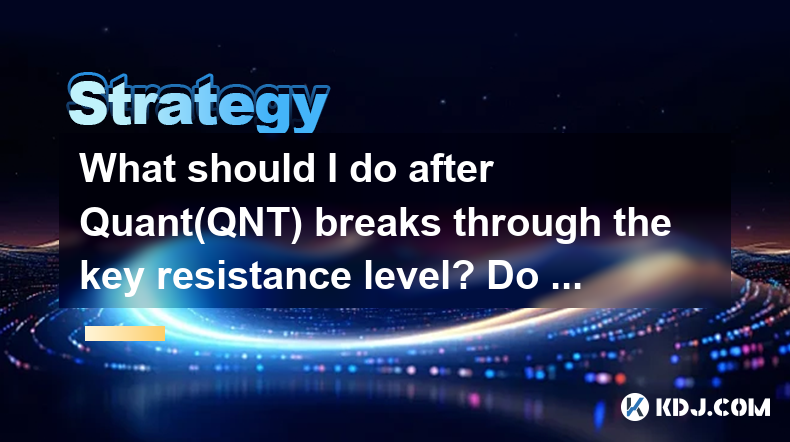-
 bitcoin
bitcoin $121833.232455 USD
-0.63% -
 ethereum
ethereum $4394.437030 USD
-2.00% -
 tether
tether $1.000570 USD
0.04% -
 bnb
bnb $1255.553465 USD
-3.73% -
 xrp
xrp $2.814944 USD
-1.59% -
 solana
solana $221.835346 USD
-2.40% -
 usd-coin
usd-coin $0.999869 USD
0.01% -
 dogecoin
dogecoin $0.249495 USD
-1.32% -
 tron
tron $0.336905 USD
-1.24% -
 cardano
cardano $0.816464 USD
-1.69% -
 chainlink
chainlink $22.130946 USD
-1.27% -
 hyperliquid
hyperliquid $44.208522 USD
-3.46% -
 ethena-usde
ethena-usde $1.000521 USD
0.02% -
 sui
sui $3.422897 USD
-2.51% -
 stellar
stellar $0.380164 USD
-1.31%
What should I do after Quant(QNT) breaks through the key resistance level? Do I need to set a stop loss?
After QNT breaks key resistance, confirm breakout with high volume and sustained price above level, then adjust strategy, set stop loss, and monitor continuously.
May 03, 2025 at 11:29 pm

After Quant (QNT) breaks through a key resistance level, several strategic actions can be taken to maximize potential gains and manage risks effectively. This article will guide you through the steps you should consider and whether setting a stop loss is necessary.
Understanding Key Resistance Levels
Key resistance levels are price points at which an asset tends to face selling pressure, preventing it from rising further. When QNT breaks through such a level, it suggests a strong bullish momentum, indicating that the market sentiment is shifting in favor of the buyers. This breakthrough can be a signal for traders to adjust their strategies.
Analyzing the Breakthrough
Before taking any action, it's crucial to confirm the validity of the breakout. A false breakout can lead to significant losses. To confirm the breakout, look for the following:
- Volume: A genuine breakout is often accompanied by high trading volume, indicating strong market interest.
- Price Action: The price should maintain its position above the resistance level for a sustained period, ideally closing above it on a daily chart.
- Market Sentiment: Check news, social media, and other indicators of market sentiment to ensure there's a positive outlook for QNT.
Adjusting Your Trading Strategy
Once the breakout is confirmed, you can consider the following adjustments to your trading strategy:
- Take Profits: If you entered the position before the breakout, consider taking partial profits to secure some gains while leaving the rest of your position open to benefit from further potential increases.
- Increase Position Size: If you believe in the continued upward trend, you might want to increase your position size. However, this should be done cautiously and within your risk tolerance.
- Set New Targets: Establish new price targets based on technical analysis, such as Fibonacci extensions or trend lines, to guide your exit strategy.
Setting a Stop Loss
Setting a stop loss is a critical aspect of risk management, especially after a breakout. A stop loss order helps limit potential losses by automatically selling your asset if the price falls below a certain level. Here’s how to set a stop loss after a breakout:
- Determine the Stop Loss Level: Place your stop loss just below the broken resistance level. This level acted as support before the breakout and could serve as a new support level.
- Consider Volatility: Adjust your stop loss based on the asset’s volatility. More volatile assets might require a wider stop loss to avoid being stopped out prematurely.
- Use a Trailing Stop: A trailing stop can be beneficial as it moves with the price, locking in profits while still providing downside protection.
Monitoring and Adjusting
After setting your stop loss and adjusting your strategy, continuous monitoring is essential. Here are some points to consider:
- Price Movements: Keep an eye on how QNT behaves after the breakout. If it continues to rise, you might want to adjust your stop loss higher to lock in more gains.
- Market News: Stay updated with news related to Quant and the broader crypto market, as significant news can impact price movements.
- Technical Indicators: Use technical indicators like moving averages, RSI, and MACD to gauge the strength of the trend and potential reversal points.
Managing Emotional Responses
Trading can be emotionally challenging, especially after a significant event like a breakout. Here are some tips to manage your emotions:
- Stick to Your Plan: Have a clear trading plan and adhere to it, regardless of short-term price fluctuations.
- Avoid Overtrading: Don’t make impulsive decisions based on short-term movements. Stick to your analysis and strategy.
- Take Breaks: If you find yourself becoming too emotionally involved, take a break from trading to regain perspective.
Frequently Asked Questions
Q: How can I tell if the breakout of QNT is a false one?A: To determine if the breakout is false, look for low trading volume during the breakout, a quick reversal back below the resistance level, and negative market sentiment. If these signs are present, it might be a false breakout.
Q: Should I always take profits after a breakout?A: Not necessarily. It depends on your trading strategy and risk tolerance. Taking partial profits can be a good strategy to secure some gains while leaving room for further potential increases.
Q: What other indicators can I use to confirm a breakout besides volume?A: Besides volume, you can use indicators like the Relative Strength Index (RSI) to check for overbought conditions, the Moving Average Convergence Divergence (MACD) for trend confirmation, and Bollinger Bands to assess volatility and potential breakouts.
Q: Can I use a fixed percentage for my stop loss, or should it always be based on technical levels?A: While using a fixed percentage can be a simple approach, it's often better to base your stop loss on technical levels, such as just below the broken resistance level. This method accounts for the asset's specific price action and can provide a more tailored risk management strategy.
Disclaimer:info@kdj.com
The information provided is not trading advice. kdj.com does not assume any responsibility for any investments made based on the information provided in this article. Cryptocurrencies are highly volatile and it is highly recommended that you invest with caution after thorough research!
If you believe that the content used on this website infringes your copyright, please contact us immediately (info@kdj.com) and we will delete it promptly.
- Trump Tariffs, Global Selloff, and the Bitcoin Crash: What's a New Yorker to Do?
- 2025-10-11 06:25:12
- Shiba Inu and the $1 Dream: A NYC Reality Check
- 2025-10-11 06:45:15
- Trump Tariffs, China, and a Bitcoin Fall: Decoding the Crypto Market's Reaction
- 2025-10-11 06:45:15
- Flora Growth Rebrands as ZeroStack: A $401M Bet on the $0G Token and Decentralized AI
- 2025-10-11 06:25:12
- Stablecoin Saga: USST's Peg Wobble and the Quest for Dollar Stability
- 2025-10-11 06:50:01
- Pepe, Trump, and the Meme Coin Mania: What's Hot in 2025?
- 2025-10-11 06:50:01
Related knowledge

Practical parameter settings for a Bitcoin multi-timeframe moving average system
Sep 18,2025 at 10:54pm
Optimizing Timeframe Combinations for Bitcoin Trading1. Selecting appropriate timeframes is crucial when building a multi-timeframe moving average sys...

How can I filter out false breakouts in Dogecoin high-frequency trading?
Sep 22,2025 at 01:00am
Understanding False Breakouts in Dogecoin Trading1. A false breakout occurs when Dogecoin's price appears to move beyond a defined support or resistan...

Techniques for identifying tops and bottoms in the Bitcoin on-chain NVT model
Sep 20,2025 at 07:54pm
Understanding the NVT Model in Bitcoin Analysis1. The Network Value to Transactions (NVT) ratio is often described as the 'P/E ratio' of the cryptocur...

What does the surge in open interest in Bitcoincoin futures mean?
Sep 20,2025 at 11:18pm
Understanding the Surge in Dogecoin Futures Open Interest1. A surge in open interest within Dogecoin futures indicates a growing number of active cont...

How can I use the Ethereum USDT premium to gauge market sentiment?
Sep 18,2025 at 11:55pm
Understanding the Ethereum USDT Premium1. The Ethereum USDT premium refers to the price difference between USDT (Tether) traded on Ethereum-based plat...

What should I do if Ethereum staking yields decline?
Sep 20,2025 at 06:18am
Understanding the Causes Behind Declining Ethereum Staking Yields1. The Ethereum network transitioned to a proof-of-stake consensus mechanism with the...

Practical parameter settings for a Bitcoin multi-timeframe moving average system
Sep 18,2025 at 10:54pm
Optimizing Timeframe Combinations for Bitcoin Trading1. Selecting appropriate timeframes is crucial when building a multi-timeframe moving average sys...

How can I filter out false breakouts in Dogecoin high-frequency trading?
Sep 22,2025 at 01:00am
Understanding False Breakouts in Dogecoin Trading1. A false breakout occurs when Dogecoin's price appears to move beyond a defined support or resistan...

Techniques for identifying tops and bottoms in the Bitcoin on-chain NVT model
Sep 20,2025 at 07:54pm
Understanding the NVT Model in Bitcoin Analysis1. The Network Value to Transactions (NVT) ratio is often described as the 'P/E ratio' of the cryptocur...

What does the surge in open interest in Bitcoincoin futures mean?
Sep 20,2025 at 11:18pm
Understanding the Surge in Dogecoin Futures Open Interest1. A surge in open interest within Dogecoin futures indicates a growing number of active cont...

How can I use the Ethereum USDT premium to gauge market sentiment?
Sep 18,2025 at 11:55pm
Understanding the Ethereum USDT Premium1. The Ethereum USDT premium refers to the price difference between USDT (Tether) traded on Ethereum-based plat...

What should I do if Ethereum staking yields decline?
Sep 20,2025 at 06:18am
Understanding the Causes Behind Declining Ethereum Staking Yields1. The Ethereum network transitioned to a proof-of-stake consensus mechanism with the...
See all articles










































































